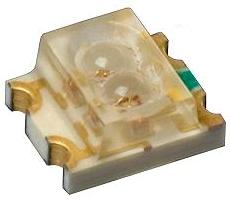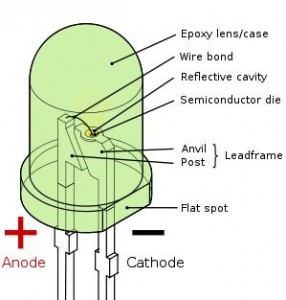LED
LED stands for Light Emitting Diode. Basically is comes under the category of Semiconductors as because they are used in Electronics and in Printed Circuit Board.
In the past days LEDs was of very less intensity and with only one color, but now a days different types of LEDs are available having different types of Color including visible, ultraviolet and infrared.
Using light as a form of indicator is widely accepted all over the world of electronics. Access Control provided by iWatch Systems has an excellent mode of indication, each LEDs present on the Panel is specific for a single operation. The LED used in the Panel is very minute in size, making it more compact and robust solid state circuit. It has few of advantages like lower energy consumption, longer life time, faster switching and greater durability and reliability.
Fig: LED used in iWatch Access Control Panel
LED is based on the basic principle of diode: When a light-emitting diode is forward biased or switched on, electrons are able to recombine with holes within the device, which releases energy in the form of photons.
Fig: Symbol of LED
Construction:
LED consists of a chip of semiconducting material doped with impurities to create a p-n junction. As in other diodes, current flows easily from the p-side, or anode, to the n-side, or cathode, but not in the reverse direction. Charge-carriers—electrons and holes—flow into the junction from electrodes with different voltages. When an electron meets a hole, it falls into a lower energy level, and releases energy in the form of a photon.
The wavelength of the light emitted, and therefore its color, depends on the band gap energy of the materials forming the p-n junction. In silicon or germanium diodes, the electrons and holes recombine by a non-radiative transition which produces no optical emission, because these are indirect band gap materials. The materials used for the LED have a direct band gap with energies corresponding to near-infrared, visible or near-ultraviolet light.
LEDs are usually built on an n-type substrate, with an electrode attached to the p-type layer deposited on its surface. In the case of LEDs, the conductor material is typically aluminum-gallium-arsenide (AlGaAs). In pure aluminum-gallium-arsenide, all of the atoms bond perfectly to their neighbors, leaving no free electrons (negatively-charged particles) to conduct electric current. In doped material, atoms change the balance, either adding free electrons or creating holes where electrons can go. Either of these additions makes the material more conductive.
Photons are the main substance behind the emission of light. Photons are released as a result of moving electrons. In an atom, electrons move in orbitals around the nucleus. For an electron to jump from a lower orbital to a higher orbital, something has to boost its energy level. Conversely, an electron releases energy when it drops from a higher orbital to a lower one. This energy is released in the form of a photon and hence it emits light.









